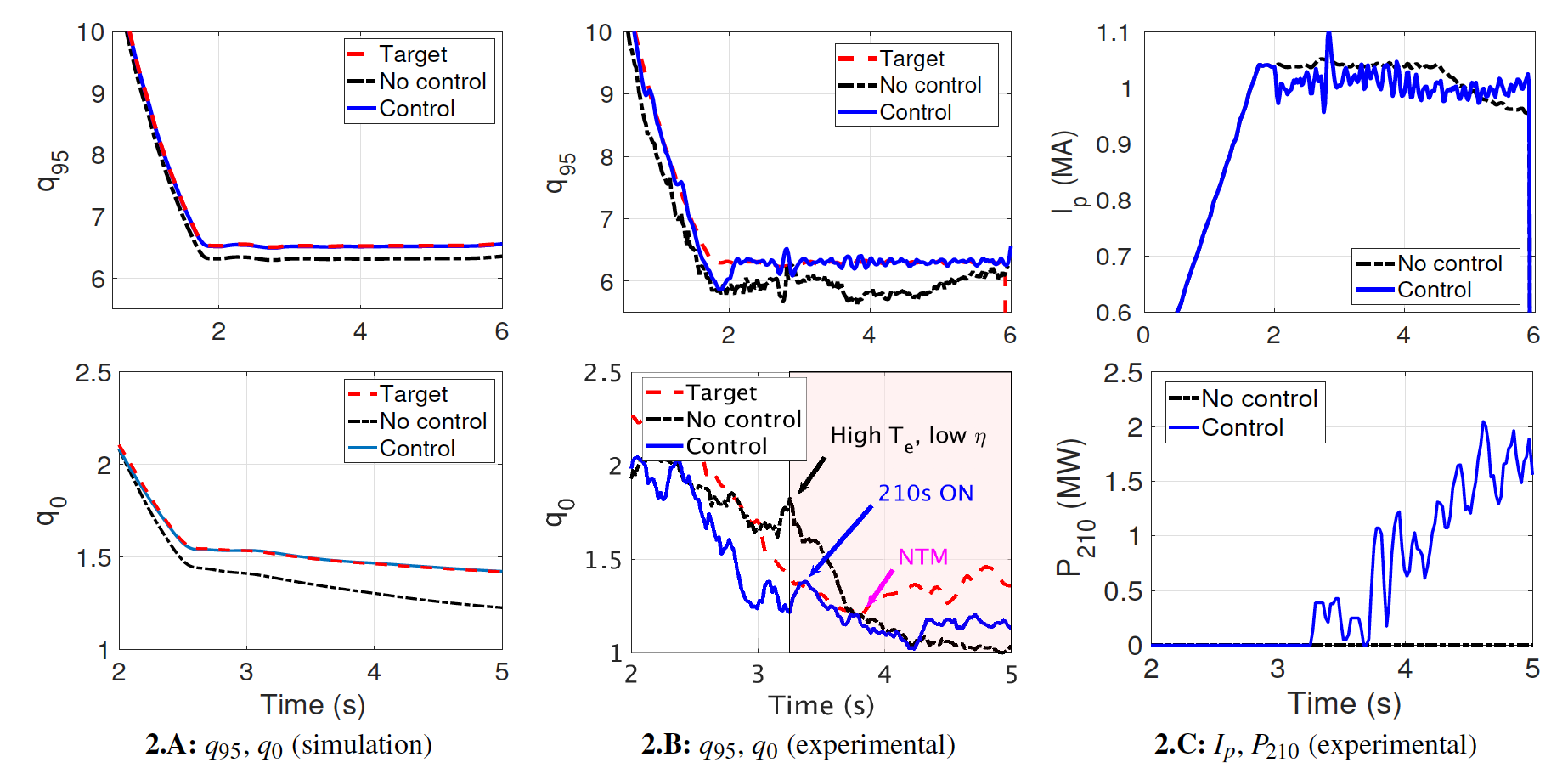Speaker
Description
A novel control architecture for simultaneous regulation of several plasma scalar variables, such as the thermal stored energy ($W$), the bulk toroidal rotation ($\Omega_\phi$), and the safety factor at various spatial locations (e.g., $q_{95}$, $q_0$), and for active suppression of Neoclassical Tearing Modes (NTMs) by means of ECCD {1} is shown to improve plasma performance even in the presence of NTMs on DIII-D. The Off-Normal Fault-Response (ONFR) system is employed as a supervisor to monitor the NTM development and assign the gyrotron authority to the competing control tasks (profile control vs NTM suppression). Instead of following the common previous approach based on attempting to regulate whole profiles {2}, a different control solution is utilized that consists in regulating such profiles only at specific spatial locations and/or by related volume-average magnitudes. Such point-wise/volume-average approach for regulating profiles in a tokamak may be more realistic in some cases due to the under-actuated nature of these devices. The integrated-control scheme has been tested in one-dimensional simulations using the Control Oriented Transport SIMulator (COTSIM), as well as in experiments in the DIII-D tokamak. The results obtained suggest that integrated control techniques may help to improve the plasma performance even in the presence of NTMs (see Fig. 1). In addition, good qualitative agreement is found between simulation and experimental results, showing that COTSIM can be a very powerful tool to advance the design of integrated control architectures {3}.

Successful regulation of $W$ has been demonstrated in DIII-D scenarios targeting $\beta_N \approx 3$ and $q_{min} \approx 1.4$ in both simulations (Fig. 1.A) and experiments (Fig. 1.B), despite the existence of a 2/1 NTM within the plasma. The IPB98(y,2)-scaling confinement factor, $H_{98(y,2)}$, is substantially improved when feedback control is employed (Fig. 1.C), possibly due to a close tracking of the $W$ target during the ramp-up and early flat-top phases of the discharge (which delays the appearance of the NTM) and during the flat-top phase (by increasing the injected power once the NTM develops). In addition, tight regulation of $W$ simultaneously with $q_{95}$ (see Fig. 2), which is equivalent to regulating $\beta_N$, and the use of preemptive NTM stabilization (see Fig. 3), also help to delay the NTM appearance and its effect on the plasma confinement, and allow for systematically achieving relatively high $\beta_N$ values ($\approx 3$) which could not be sustained without feedback. Simultaneously with $W$ regulation, control of $q_{95}$ and $q_0$ (see Fig. 2.A), as well as $\Omega_\phi$ (not shown in this synopsis), has been achieved in one-dimensional simulations for the same steady-state high-$q_{min}$ scenario using COTSIM. During experiments in DIII-D, $q_{95}$ was successfully controlled (see Fig. 2.B) under feedback by varying $I_p$ (Fig. 2.C), but the unavailability of counter-$I_p$ neutral beam injectors did not allow for $\Omega_\phi$ regulation. Moreover, the controller's performance to regulate $q_0$ was significantly worsened in experiments (see Fig. 2.B) as a result of having substantially limited off-axis power (the co-$I_p$, off-axis 210 beamline could only be employed for 2 s). When the 210 beamline was turned on at 3.25 s (see Fig. 2.C), $q_0$ gets close to its target for a short period of time. Later development of the 2/1 NTM caused a slight decrease in $W$ (with the associated reduction in the electron temperature and increase in the plasma resistivity), which relaxed the $q$ profile and made it difficult for the controller to raise $q_0$ in order to reach the desired target.

Active NTM suppression techniques by means of ECCD deposition at the applicable rational surface were also tested at the same time that regulation of the aforementioned individual scalars was carried out. Simulation results obtained with COTSIM estimated that the 2/1 NTM could be totally suppressed with about 3 MW of EC power in these steady-state high-$q_{min}$ scenarios (see Fig. 3) for initial seed islands of width 10 cm. During experiments, lack of EC power (1.5 MW maximum using the gyrotrons “Luke”, “Leia” and “Tinman”) and defective poloidal-mirror steering did not allow for total NTM suppression, although a delay in its development and a lower MHD amplitude were achieved.

These initial results suggest that feedback-control techniques that integrate individual-scalar-variable regulation algorithms and NTM suppression may substantially improve the plasma performance in steady-state high-$q_{min}$ scenarios in DIII-D. However, actuator availability is critical to achieve successful regulation of the different scalars. Further efforts will focus on developing control algorithms for scalars (possibly adding more scalars such as $l_i$, $\beta_p$ or $q_{min}$) and MHD stability that have greater levels of integration (e.g., with proximity controllers), as well as actuator management schemes. The final goals are to increase the effectiveness of the NTM suppression mechanisms, improve the controller’s performance, and achieve higher $\beta_N$ values.
Work supported in part by the U.S. Department of Energy under DE-SC0010661 and DE-FC02-04E54698.
{1} LA HAYE, R. J., GUNTER, S., HUMPHREYS, D. A., et al., Physics of Plasmas 9 (2002) 2051.
{2} WEHNER, W., BARTON, J., LAURET, M., et al., Fusion Engineering and Design 123 (2017) 513 , Proceedings of the 29th Symposium on Fusion Technology (SOFT-29) Prague, Czech Republic, September 5-9, 2016.
{3} HUMPHREYS, D., AMBROSINO, G., DE VRIES, P., et al., Physics of Plasmas 22 (2015) 021806.
| Affiliation | Lehigh University |
|---|---|
| Country or International Organization | United States |
